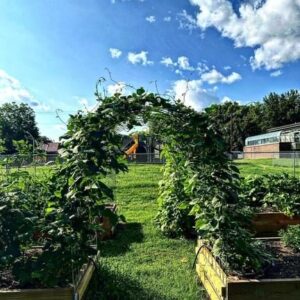During an August 2023 special election, residents of Batesville voted overwhelmingly in favor of four ballot issues that marked a turning point for the city. These issues secured a $25 million investment for the expansion and improvement of the city’s parks and recreation facilities as well as an additional $110 million to go toward the construction of a new water treatment system.
Opportunities to reshape a city’s infrastructure and enrich its social and recreational offerings without a tax increase seldom arise. But when they do, seizing these moments requires more than a stroke of luck; it demands collaboration, a willingness to learn, and data-informed planning.
A Seat at the Table
Over the past two years, leaders from the Batesville Area Chamber of Commerce, the City of Batesville, and the Batesville School District have been active participants in the Cities Connecting Children to Nature (CCCN) initiative. This initiative, a partnership between the National League of Cities and the Children & Nature Network, brings together municipal leaders and their community partners nationwide with a shared goal of connecting all children to the benefits of nature.
Jamie Rayford, chief operating officer for the Batesville Area Chamber of Commerce and chair of the Excel by Eight steering committee for Independence County, has been a consistent participant in CCCN calls. She attributes Batesville’s involvement in this national network to an improved understanding of how to integrate Independence County’s early development data into city planning and infrastructure.
“We had the opportunity to participate in calls with people representing cities with amazing recreational programs,” Rayford said. “These calls not only reinforced the research-based, social-emotional learning benefits that come from connecting children with nature but also ignited some sparks about potential partnerships that would lead to transformative systems change.”
Rayford said conversations with other members of CCCN helped the Independence County steering committee reimagine how to incorporate these ideas into their E8 strategies map, a document that identifies five community goals based on results from the Early Development Instrument (EDI). This 103-item questionnaire is completed by kindergarten teachers in the second half of the school year and measures children’s ability to meet age-appropriate developmental expectations.
When the Excel by Eight steering committee in Batesville initially set its goals based on the results of the EDI, they recognized that improving fine motor skills and gross motor skills among young children could happen through outdoor play – from digging in the dirt to running, jumping, and climbing.
As the steering committee built their action plan, they came up with an idea to have the Mayor of Batesville issue a proclamation for an annual Day of Play. Rayford said it was a worthy suggestion considering the knowledge they had at the time.
“On that Day of Play, we would provide all types of opportunities for kids to be involved in play, and we’d raise awareness about the importance of families getting outside and building these skills with their children,” Rayford said. “That was the vision; that was how far our brains could conceptualize at that moment because we had no other resources and no one to help us see that this could be so much bigger than an annual program.”
Data Meets Opportunity
Results from Independence County’s initial EDI assessment showed that less than half of children entered kindergarten physically and socially on-track and ready to learn. As a result, the Independence County E8 steering committee developed goals that support providing more opportunities for families to build gross and fine motor skills in their young children while demonstrating and teaching behaviors that help and support others.
“We were looking for a way to build out our E8 strategies map and start action planning around what we can do to support teachers, kids, families, and schools to improve these findings,” Rayford said. “Integrating more nature and outdoor play into our city’s parks emerged as a key strategy that we could start action planning around.”
To establish a baseline of current park offerings, the E8 steering committee asked fifth graders from Sulfur Rock Elementary East to complete an audit of Batesville’s city parks. Their findings showed that existing playground equipment was primarily geared toward children ages 6-12, emphasizing the need to invest in play spaces that would benefit children ages 5 and younger.
“As adults, we are not the experts on children’s play spaces,” Rayford said. “We wanted to get a child’s perspective on what attracts them to the parks as well as what makes them feel unsafe. We chose fifth graders because they were old enough to understand the purpose of the audit but still young enough to enjoy playing at the park.”
The City’s parks and recreation department was already in the process of writing a grant proposal to develop a green space next to a splash pad in the community, which is used heavily by young children. Thanks to the data from the EDI, the conversations with other cities, and the parks audit, the parks department included language in the request for proposal that specified that equipment had to build fine and gross motor skills as well as improve social skills for kids ages 0-5.
“So by incorporating those requirements into the RFP and sending that out to vendors, the City received proposals that included recreation options for infants, toddlers, and preschoolers,” Rayford said. “The $350,000 investment will be installed soon.”
Rayford said the E8 steering committee considered this new recreational area to be their “big win” for kids 0 to 5. To their surprise, Mayor Rick Elumbaugh approached them a few months later about an opportunity to refinance existing recreation bonds and use $25 million of those funds to make a substantial investment in parks and recreation. The committee was able to refer to the Excel by Eight goals and the Batesville Chamber’s Impact Independence County plans to share what the data said and what the community members wanted.
“It was the perfect opportunity for all those things to collide,” Rayford said. “We got lucky that the City decided that they would like to refinance the recreation bonds around the same time we were thinking more broadly about our parks infrastructure,” Rayford said. “So we had an opportunity to jump in and say, ‘Hey, we need some of these things to support our early childhood strategy of developing social-emotional skills and fine and gross motor skills.’ And we used this in the Building a Better Batesville campaign to expand Riverside Park.”
Ecological Design Group and Taggart Architects have been selected to design the reimagined Riverside Park. The city is also working with pediatricians and occupational and physical therapists to ensure the play spaces are sensory-friendly and accessible for all children.
“For the master planning of Riverside Park, we wanted to choose an architecture and engineering firm that was versed in nature design and had experience creating outdoor, ecological spaces that use the natural environment to provide opportunities for families – especially families with young kids – to interact with it,” Rayford said.
Putting the Plan into Action

Emphasis on nature play goes beyond Batesville’s public parks. Batesville Preschool is expanding its nature offerings in outdoor play spaces, which is not an easy feat for a campus located in the heart of the city.
“Where our preschool sits is right in the middle of concrete along one of the most traveled roads in Independence County,” said Lorrie McClure, Community Schools site director and home visiting coordinator for the Batesville School District. “So, there’s not a lot of nature around to help build fine and gross motor skills.”
Jessica Angel, the district’s community engagement coordinator of Save the Children and the Community Schools site coordinator, has worked with landscape architects to help enhance the outdoor play spaces at Batesville Preschool in ways that go beyond new playground structures. She has combined her lifelong love of nature with research about the importance of outdoor play in early childhood development.
“I basically grew up playing in the dirt at my grandparents’ house, and I really wanted to incorporate the hands-on, farm-to-school aspect of learning into Batesville Preschool and the Batesville School District when I was hired,” she said.

Angel has secured grant funding and donations from community partners to help incorporate nature and gardening into the preschool’s outdoor play area. She initiated the project with six raised beds containing pumpkins, sunflowers, and a sensory garden filled with lavender, mint, and basil to captivate the children’s five senses. Arbors used to grow green beans combine education and play, teaching children about the origin of their food while also providing them with a structure to run through and spark their imaginations. Future plans include developing a nature trail and expanding the nature playscape into a nearby hillside.
“The kids love it,” Angel said. “They love being in the garden, and they love being outside and enjoying everything that it has to offer.”
In addition to giving children more opportunities to play and learn about nature, the garden provides fresh foods to residents who need it most. More than 100 pounds of food grown in the garden was donated to the school district’s food pantry, which is located at Batesville Preschool.
“You build better communities when everyone partners,” McClure said. “Build bridges, not walls.”
The Long Game
Rayford said unlike planning a one-time Day of Play to promote the importance of getting outside, coming up with strategies that can change systems and transform communities requires time, intention, and collaboration.
“Had we not started two years ago thinking about how to build up strategies for these parts of our Excel by Eight goals, I think we would still be sitting here thinking we don’t know how to create systems change for families in this space,” Rayford said. “My advice for anyone who is trying to bring about change in their communities is to participate in learning. We would have never thought about nature and outdoor play as a strategy without trying to learn from others.”
Rayford described this approach as a “learning journey.” She emphasized the importance of conducting research and asking people from other communities who have implemented community plans successfully about their experiences. Additionally, having data-informed goals helps the community identify opportunities that will support those goals.
“We pull E8 into every conversation in our community and stay committed and consistent with our messaging,” she said. “We make sure families with children ages 8 and younger are not left out of the conversation.”

